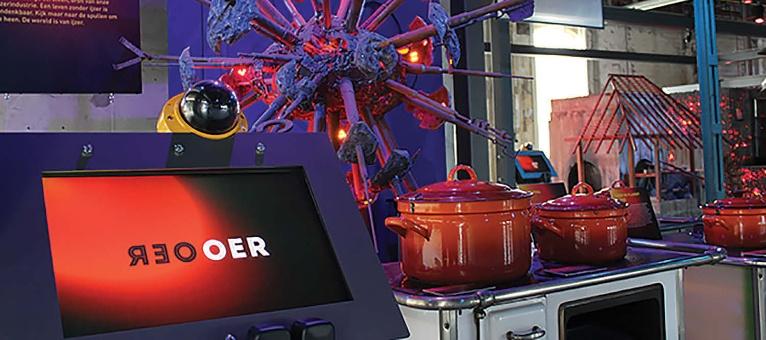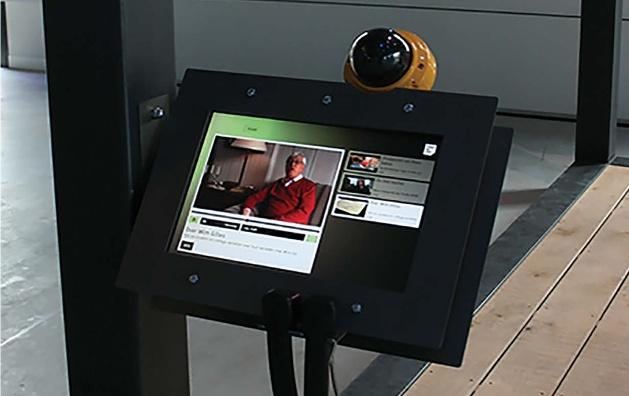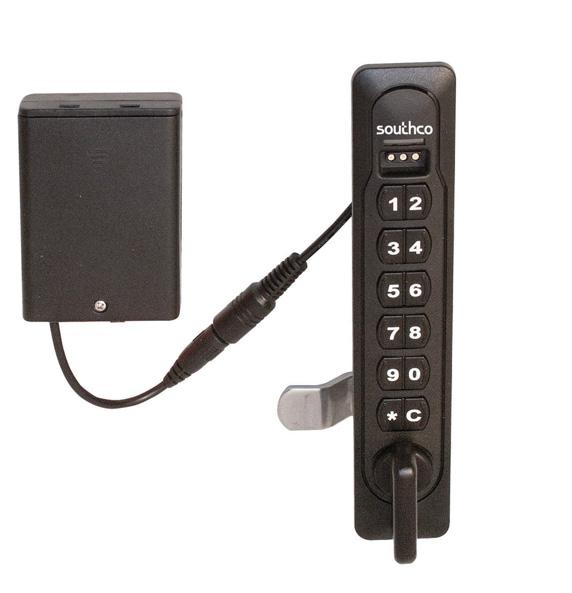
12 minute read
Facial Recognition Enhances Museum Experience
by IdeaSoil
Ken’s
VIEW
Advertisement
If you’re keeping track of things destined for the dustbin of history—hotel desks, hotel restaurants, and guestroom light switches that work (just to single out a specifi c industry)—you can add compact-fl uorescent lamps (CFLs) to the list of endangered stuff.
First introduced in the 1980s, CFLs were hyped as Light Bulb 2.0, but like many 2.0 innovations, they’ve failed miserably. They never caught on, perhaps because many people hated them. General Electric recently announced it will stop making the contorted light sources. CFLs account for just 15% of sales in the U.S., the company says by way of explanation.
Enter Lightbulb 3.0 or LEDs. Even though they initially cost a ton of money, LEDs persisted and prices have dropped, not unlike the relative cost of smartphones, computers, and other digital doohickeys. Beyond that, they can perform many more functions than incandescents and CFLs ever dreamed of, opening new possibilities in lighting design.
But LED’s won’t solve all of lighting’s dilemmas. LEDs are hard to recycle, just like electronics of any sort, reports the UK’s Guardian. But what if Wi-Fi were used to connect lamps to a supplier that could then send a replacement notifi cation and collect the old bulbs? That’s assuming users will not ignore the email or text. Millennials, I’m told, don’t do email.
Worse, however, is a suggested service-versusownership model. Users would rent bulbs instead of owning them. This is like the software model in which users pay an annual fee rather than outright purchase the software. This usually entails an automatic deduction from one’s
Anything 2.0 Is So Over
credit card, another business model much beloved by big companies. For families struggling to pay a mortgage or recent college graduates struggling to eat, these insidiously multiplying, out-of-mind, automatically renewed deductions are a fi nancial disaster waiting to happen.
The good news is that libraries and books don’t seem to be following the same road to oblivion as CFLs. In fact, the demise of either is overstated. Sales of e-books are leveling off or may be declining, although it’s diffi cult to fi nd agreement on that. Nevertheless, after bookstore chains such as Borders were decimated, some independent booksellers say they’re doing well. The Washington Post reports that some people who aren’t supposed to remember what it’s like to read a book, in fact prefer print. A British trade publication says print is more popular than e-books amongst readers aged 16 to 24.
Older readers predictably say they like the feel and smell of books. I’d take that sentiment a step further. Go to any library or bookstore, and you’ll notice that no two books look alike. Aside from the cover art, which surely will be reproduced poorly in digital editions, each book has distinctive design elements, such as typeface, leading, margins, paper stock, size, and weight.
Considerable design thought has been given to books. Readers may not be consciously aware of book design, but it infl uences the reading experience and even purchasing decisions, just as architecture subtly infl uences reaction to built environments. E-readers, on the other hand, have limited and dismal typefaces, poor leading and hyphenation, and awkward word spacing; they just aren’t particularly attractive. One gets bored by their visual monotony. If I could fi nd one of my e-readers, I could no doubt enumerate more faults, but I don’t know where the things have got to.
Libraries, of course, can’t pretend the digital revolution never happened or that it doesn’t appeal strongly to some people. Derek Jones of Perkins + Will related that while people are nostalgic about the serendipitous browsing of library stacks and fi nding just the book one didn’t know one needed, few of them actually do that any longer. Instead, they make discoveries online—which may lead them eventually to their public library—but browsing the stacks is regrettably passé for most people.
So that’s the mixed bag of good and bad news for this month—save for one fi nal, off-topic warning: Beware hoverboards—which don’t actually hover and are sometimes known as explosions waiting to happen. Some say they were one of the hottest gifts of the recent holiday season, neglecting to say one reason for their hotness was they sometimes caught fi re or exploded because of faulty lithium-ion batteries—which, in turn, is the reason major airlines have banned the things from their fl ights. A blessing, I say, because aside from safety concerns, passengers already carry enough junk aboard.
Now an enterprising company is marketing fi resafe bags for the deadly toys, good to avoid burning the house down, it’s said. If you care to note my prediction, hoverboards will go the way of CFLs—just sooner.
But enough of this; I’m headed down to my local library, which odds are will outlast CFLs, hoverboards, and similar “innovations.” There I’ll browse the stacks and hope to avoid combustible playthings.
— Kenneth W. Betz, Senior Editor
In other areas, stack height has dwindled in most libraries, dropping from 88 to 94 in. to 42 and even 36 in., so there are clear sightlines. “People want to be able to see and navigate the whole space and not have large visual obstructions,” Jones said.
“The biggest driver in utilities is cooling and electrical,” Derek Jones added. “A lot of our clients told us that the duration of their patrons’ stay was highly determined by the battery life of their computer, so if you want people to stay longer you need access to power— and the traditional library had only a few power points. Now you see every table and every chair is connected with power and USB; lockers have plugs in them so people can charge their devices while they’re off doing something else.”
SPACE ALLOCATION Space allocation is another adjustment in contemporary library design. Areas for storing books and periodicals are being condensed, for example. “The question libraries are asking is, ‘Should I pay $X to store books, or pay half of $X for condensed storage of books and allow more space for study and collaboration areas?’ The latter often better supports community members who need the resources—or need to learn how to get them. So we are also seeing more rooms with limited privacy and perhaps a higher level of activity, although they offer some privacy for groups and collaborative learning,” Carrier said.
In the final analysis, libraries are far from obsolete, even as their service model continues to evolve. CA
Want more information? The resources below are linked on our website at commercialarchitecturemagazine.com and our digital magazine at commercialarchitecturemagazine.com/ digital/mar2016.
Library Design Showcase
State of America’s Libraries
Better Public Libraries
21st Century Libraries: Changing Forms, Changing Futures
Designing Better Libraries blog
Public Libraries In The United States Survey
Designed and engineered for the user in mind, the new Acousti-Clear ® acoustical glass partition systems provides an all-inclusive family of acoustical glass wall products which provides both the advantages of moveable partitions as well as fixed office fronts within any space. By providing matching ultra-sleek and contemporary panel frames between products, each space can mix and match between operable and fixed panels seamlessly to accomplish ultimate flexibility and space desirability.
• Acoustically Rated Glass Wall Systems 45 & 50 STC • Single Panel, Paired Panel, Demountable • Limitless Design, Custom Finishes • Motorized & Automatic Seal Options
Visit modernfold.com or call 800.869.9685 for more information.
Download the new STC Sound Experience App to hear the difference only Modernfold products can make in your space.


Facial Recognition Enhances Museum Experience
Taking a biometric access-control system beyond its normal use helps museum personnel and architects create more effective designs.
The ICER (Industry, Culture, Education, and Recreation) Innovation Center is a museum that showcases iron and manufacturing innovation and technology in the town of Ulft, in the Netherlands. Housed in a former deburring department, the museum has become a success with patrons of all ages and is now a highly experiential facility dedicated to increasing the understanding of the value of innovation.
As part of the design, museum personnel were interested in providing an innovative solution to better engage visitors. That solution materialized in the form of the In Motion Identification (IMID) access-control mechanism, manufactured by FST Biometrics Corp., headquartered in Rishon Lezion, Israel. The company’s U.S. operation is FST Biometrics America Inc., New York. The system was designed by Ensura Solutions BV, an FST Biometrics integrator, headquartered in the Netherlands.
THE CHALLENGE Ensura was presented with a challenge to provide a biometrics-based system that would be intuitive and easy-to-use for museum visitors, while showcasing the impact innovation can
Queen Maxima of the Netherlands registers with a facial-recognition station in the ICER Innovation Center. The Dutchbased museum uses the FST Biometrics IMID technology to allow visitors to gain personalized information about museum exhibits as they pass through interactive checkpoints.
have on their lives. The system involves biometric checkpoints, located throughout the museum, at which visitors use the IMID facial-recognition technology to gain valuable information about the museum and be provided with a personalized experience.
The initial identification point is at the museum’s entrance and offers an opt-in feature for patrons wishing to receive a more personalized visitor experience. This initial check-in site allows the biometric ID system to pro

Above. The IMID facial-recognition system identifi es visitors as they approach exhibits and provides information that enhances the overall experience. Photos: ICER.EU sands of people, each of whom has had the option to experience the museum through the IMID system. Kees Nieuwenhuijse, interim director of ICER Innovation Center, said, “The interactive In Motion Recognition system, provided to ICER by Ensura Solutions BV, FST Biometrics’ regional distributor, is a perfect complement to the exhibits we have here at the innovation center. FST’s technology helps our visitors maximize their time at ICER at the pace that makes sense for them, since FST’s
cess incoming visitors in a timely manner—the system requires less than 10 sec. for enrollment—
Below. When a visitor’s face is recognized, displays provide customized information about the exhibit that helps enhance the patron’s experience while providing museum personnel with information about guest traffi c and interests. [facial-recognition] system is able to personalize the ICER experience for each individual.”
thereby preventing a bottleneck at the facility’s entry point. At the first checkpoint following entry/enrollment, visitors are asked to provide their name and e-mail address. If they do so, the museum can later send museum guests personalized communications tailored to the exhibits they visited.
Visitors who select the biometric identification option are assigned a temporary system ID (not made visible to them) that is used to correlate their identity to the sites at the museum that they subsequently choose to visit. The 15 biometric identification checkpoints (positioned beyond the unit at the visitor entrance) are housed in display cabinets that contain the museum’s metallurgy and iron-making exhibits. Given that the exhibits are constantly changing, tracking installation popularity helps museum personnel decide which displays to keep, remove, or modify.

Prior to installation, the Ensura integration team was tasked with verifying conditions at the exhibits were suitable for the identification-station specifications, including adequate approach and identification distances in effect at each checkpoint.
SUCCESS! To date, the ICER Museum has hosted tens of thou
Bas de Leeuw, CEO of Ensura Solutions BV, said, “The way we have used In Motion Identification at ICER is a great example of how innovative and new technology can change our lives.”
Deployment of FST’s biometric solution demonstrates valuable use cases for other museum operators seeking to add enhanced functionality to their visitor experiences. The addition of biometric identification checkpoints generally requires minimal architectural accommodation to perform properly.
Once installed, a wealth of information about the building’s use becomes available to management and architects. Potential applications include effective management of constantly-changing museum exhibits, the ability to execute personalized marketing campaigns based on actual engagement with the building’s visitor experiences, and data analysis to better plan layouts to accommodate the flow of visitors. CA
Want more information? The resources below are linked on our website at commercialarchitecturemagazine.com and our digital magazine at commercialarchitecturemagazine.com/digital/mar2016.
Circle 4 on the Reader Service Card.
Visit the ICER Innovation Center website. Watch a video about the FST Biometrics IMID system.
Download specifi cs about the IMID system.
EDITORS’ CHOICE
Architectural dimming-panel platform
LCAP:
Lighting-control and automation-panel series Integrates with DLM and other systems Dimming curves can be customized

LCAP lighting-control and automation-panel series was developed by the company and Vantage Controls, Orem, UT. Products in the series include lighting-control panels and a range of interfaces. The platform can also integrate with the DLM system, and with A/V, shades, climate, and other systems. Said to be easy to specify, install, commission, and use, the platform adapts to changing project requirements and products such as LEDs. The panels provide modular pre-configured architectural dimming and integration options. The dimming curve for each dimming channel can be independently customized for starting and stopping points as well as linearity. This provides smooth dimming and consistent lighting when using mixed lighting types or brands.
WattStopper, Santa Clara, CA Circle 50 wattstopper.com

Rack cable management The B-Line series rack cable management (RCM) and rack cable management plus (RCM+) lines for enterprise and high-density networking applications provide ergonomic, sleek, and reported cost-effective options for standard networking closet applications. The RCM line offers a dual-density vertical cable manager with a fullheight door that is compatible with the RCM+ standard horizontal cable manager and features sloped high-density fingers for added support with a plastic back-gate kit to contain cables.
Eaton, Highland, IL Circle 51 eaton.com
Self-contained electronic lock SC self-contained electronic locking system incorporates an access-control device, electronic lock, electrical override, and power supply. The AA battery-operated unit is available with keypad or RFID access. The single-component design mounts into a standard 25 x 150 panel prep.
Southco Inc., Concordville, PA Circle 52 southco.com


Video security Ocularis 5 video-management software integrates with the latest version of IQeye megapixel cameras from Vicon Industries. Ocularis 5 is based on a recorder that accommodates a high density of cameras/recorder while maximizing HDD storage without user configuration. Multiple recorders can be combined under the same Base. IQeye cameras are said to provide superior image quality, stability, and reliability in harsh environments.







